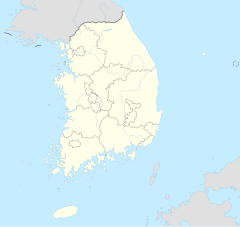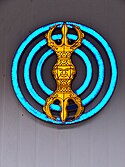
Maitreya (Sanskrit) or Metteyya (Pali), is a bodhisattva who is regarded as the future Buddha of this world in all schools of Buddhism, prophesied to become Maitreya Buddha or Metteyya Buddha. In some Buddhist literature, such as the Amitabha Sutra and the Lotus Sutra, he is also referred to as Ajitā. In Tibetan Buddhism he is known as the "Lord of Love" or the "Noble Loving One". The root of his name is the Sanskrit word maitrī. The name Maitreya is also related to the Indo-Iranian name Mitra.
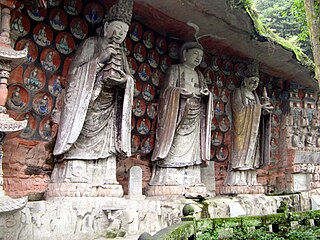
The Huayan school of Buddhism is a Mahayana Buddhist tradition that developed in China during the Tang dynasty (618-907). The Huayan worldview is based primarily on the Buddhāvataṃsaka Sūtra as well as on the works of Huayan patriarchs, like Zhiyan (602–668), Fazang (643–712), Chengguan (738–839), Zongmi (780–841) and Li Tongxuan (635–730).
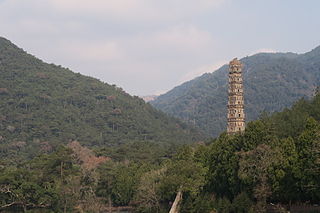
Tiantai or T'ien-t'ai is an East Asian Buddhist school of Mahāyāna Buddhism that developed in 6th-century China. Tiantai Buddhism emphasizes the "One Vehicle" (Ekayāna) doctrine derived from the Lotus Sūtra as well as Mādhyamaka philosophy, particularly as articulated in the works of the 4th patriarch Zhiyi. Brook Ziporyn, professor of ancient and medieval Chinese religion and philosophy, states that Tiantai Buddhism is "the earliest attempt at a thoroughgoing Sinitic reworking of the Indian Buddhist tradition." According to Paul Swanson, scholar of Buddhist studies, Tiantai Buddhism grew to become "one of the most influential Buddhist traditions in China and Japan."
Cheontae is the Korean descendant of the Chinese Buddhist school Tiantai. Tiantai was introduced to Korea a couple of times during earlier periods, but was not firmly established until the time of Uicheon (1055-1101) who established Cheontae in Goryeo as an independent school.
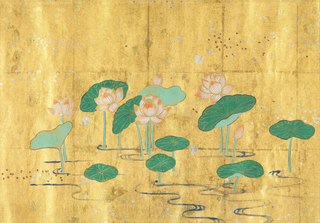
The Lotus Sūtra is one of the most influential and venerated Buddhist Mahāyāna sūtras. It is the main scripture on which the Tiantai along with its derivative schools, the Japanese Tendai, Korean Cheontae, Vietnamese Thiên Thai and Nichiren schools of Buddhism were established. It is also influential for other East Asian Buddhist schools, such as Zen. According to the British Buddhologist Paul Williams, "For many Buddhists in East Asia since early times, the Lotus Sūtra contains the final teaching of Shakyamuni Buddha—complete and sufficient for salvation." The American Buddhologist Donald S. Lopez Jr. writes that the Lotus Sūtra "is arguably the most famous of all Buddhist texts," presenting "a radical re-vision of both the Buddhist path and of the person of the Buddha."

Zhiyi also Chen De'an (陳德安), is the fourth patriarch of the Tiantai tradition of Buddhism in China. His standard title was Śramaṇa Zhiyi (沙門智顗), linking him to the broad tradition of Indian asceticism. Zhiyi is famous for being the first in the history of Chinese Buddhism to elaborate a complete, critical and systematic classification of the Buddhist teachings. He is also regarded as the first major figure to make a significant break from the Indian tradition, to form an indigenous Chinese system.
Buddhist temples are an important part of the Korean landscape. Most Korean temples have names ending in -sa, which means "monastery" in Sino-Korean. Many temples participate in the Templestay program, where visitors can experience Buddhist culture and even stay at the temple overnight.

Bulguksa (Korean: 불국사) is a Buddhist temple on Tohamsan, in Jinhyeon-dong, Gyeongju, North Gyeongsang Province, South Korea.

Tongdosa is a head temple of the Jogye Order of Korean Buddhism and in the southern part of Mt. Chiseosan near Yangsan, South Gyeongsang Province, South Korea.

The Bodhisattva vow is a vow taken by some Mahāyāna Buddhists to achieve full buddhahood for the sake of all sentient beings. One who has taken the vow is nominally known as a bodhisattva. This can be done by venerating all Buddhas and by cultivating supreme moral and spiritual perfection, to be placed in the service of others. In particular, bodhisattvas promise to practice the six perfections of giving, moral discipline, patience, effort, concentration and wisdom in order to fulfill their bodhicitta aim of attaining buddhahood for the sake of all beings.
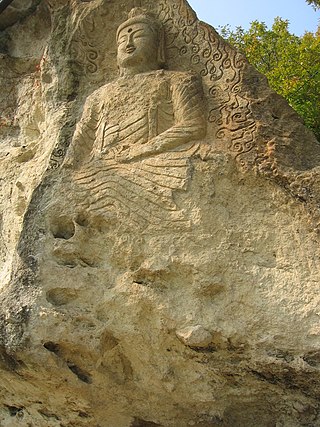
Golgulsa is located 20 km east of the ancient Silla Dynasty capital city of Gyeongju in Southeastern Korea. In the Gogulsa area can be found the oldest historical Buddhist ruins on Mt. Hamwol and the only cave temple in Korea.

Woljeongsa (Korean: 월정사) is a head temple of the Jogye Order of Korean Buddhism, located on the eastern slopes of Odaesan in Pyeongchang County, Gangwon Province, South Korea. Woljeongsa was founded in 643 by the Silla monk Jajang.

Yongjusa is a head temple of the Jogye Order of Korean Buddhism. It is located in on the slopes of Hwasan in Taean-eup, Hwaseong, in the province of Gyeonggi, South Korea. The temple's name means "dragon jewel temple."

Geumsansa is a temple of the Jogye Order of Korean Buddhism standing on the slopes of Moaksan in Gimje City, Jeollabuk-do, South Korea.

The Three Ages of Buddhism, also known as the Three Ages of the Dharma, are three divisions of time following Shakyamuni Buddha's death and passing into Nirvana in East Asian Buddhism.
The Taego Order or Taego-jong is the second largest order in Korean Seon, the Korean branch of Chan Buddhism.

This is the glossary of Japanese Buddhism, including major terms the casual reader might find useful in understanding articles on the subject. Words followed by an asterisk (*) are illustrated by an image in one of the photo galleries. Within definitions, words set in boldface are defined elsewhere in the glossary.

Gakhwangjeon Hall (Korean: 각황전) is a hall of worship at Hwaeomsa, a Buddhist temple in Gurye County, South Jeolla Province, South Korea. It is one of the monastery's two principal halls and overlooks the northwest end of the courtyard. In addition to being one of the largest Buddhist halls in South Korea, Gakhwangjeon Hall is registered as National Treasure 67 by the Cultural Heritage Administration.

The Buddha Tooth Relic Temple and Museum is a Buddhist temple and museum complex located in the Chinatown district of Singapore. The temple's monastics and devotees officially practice Chinese Buddhism.

Naesosa (Korean: 내소사), or Naeso Temple, is a Korean Buddhist temple located at the base of the mountain Naebyeongsan in Jinseo-myeon, Buan County, Jeonbuk State, South Korea.

